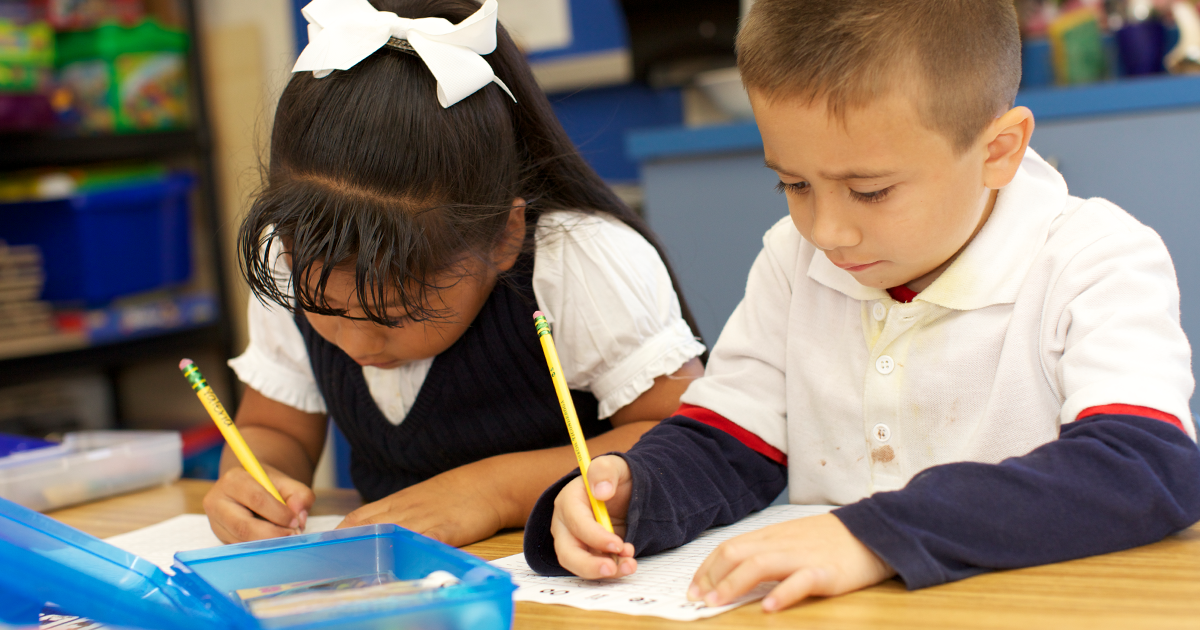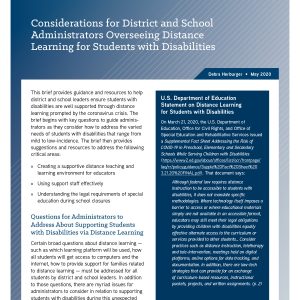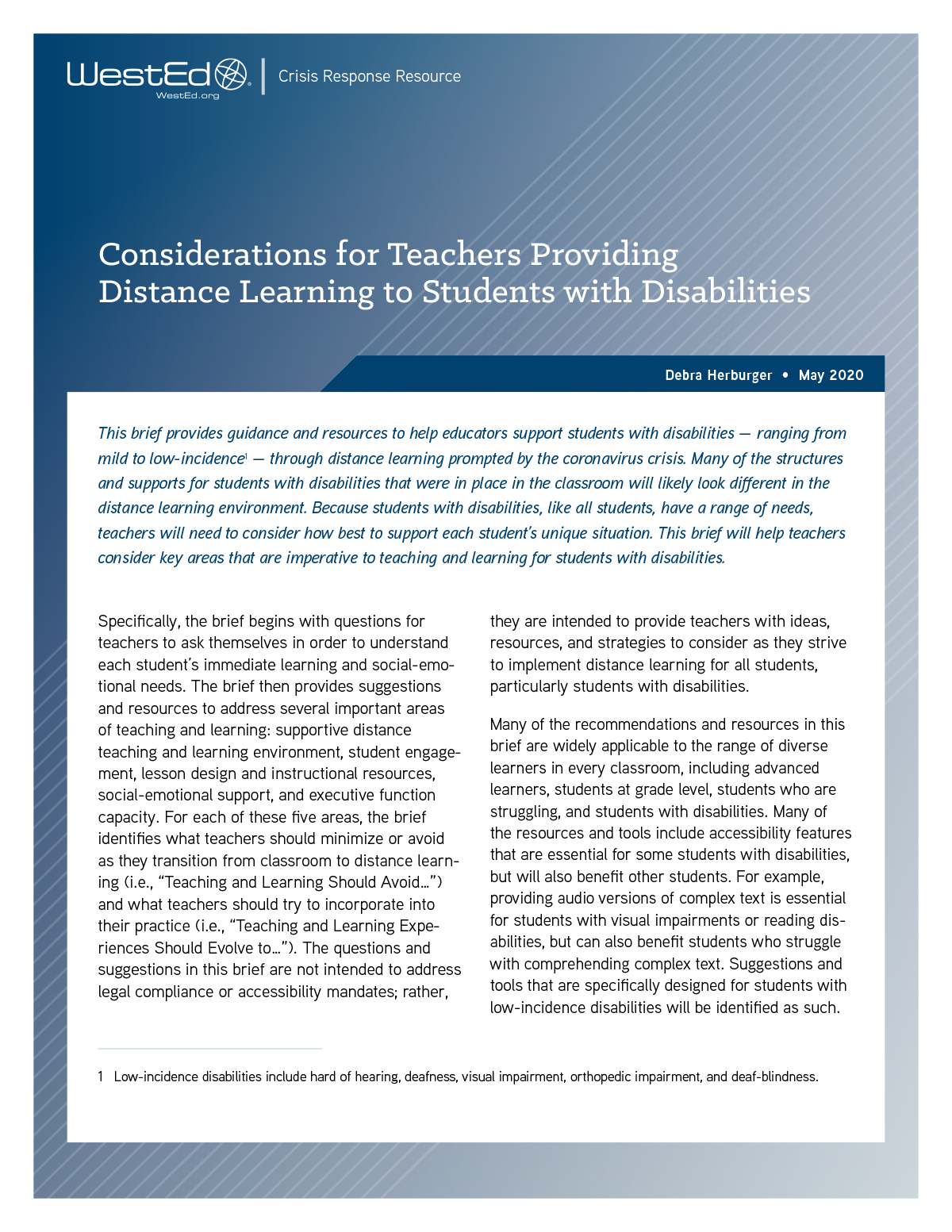Classroom Interactions During Remote Learning: Considerations for Educators
Posted on

Written by Mark Jutabha, School Improvement Facilitator with WestEd’s Comprehensive School Assistance Program.
Since March 2020, our teaching and learning landscape has been upended by the challenges presented by the coronavirus. However, the abrupt school closures and inconsistent virtual learning that it forced provides opportunities to surface what works well and what needs to be redesigned in school infrastructure, device and internet access, school day scheduling, and teaching and learning. Schools are unlikely to return to business as usual soon, and these important issues can only be addressed once educators define what teaching and learning will look like in this new world.
This blog presents considerations for educators as they redesign classroom instruction in virtual or onsite spaces. As districts plan for fall 2020, optimal solutions must address interactions between students and teachers and between students and their peers in order to create productive classroom experiences.
Interactions between teachers and students
The pandemic shines light on needed change by requiring teachers to evolve their teaching style to accommodate remote and distance learning. Specifically, it forces the conversation on how teachers can be efficient with instructional choices to maximize instructional time with students. One of those choices should address the question, “Who does the talking in a virtual classroom?”
Research shows teachers do the majority of talking in traditional classrooms, typically 80 to 90 percent (Fisher et al., 2017). This is known as a didactic teaching style. Because so much of a teaching period is taken up by teacher talk, students often do not get extended opportunities to think, work, talk alongside their peers, or receive feedback on their thinking from the teacher. This challenge is compounded in a virtual space as teachers work to find ways to elicit student participation.
Teachers trying to replicate a didactic teaching style will run into the same pre-pandemic student participation challenges. The ramifications for student learning are documented in the research such that they: forget the content, are unable to apply learning to new situations, and are 1.5 times more likely to fail a math course (Freeman et al., 2014; Sousa, 2017).
Interaction with peers
Students, especially those students at higher risk of dropping out of school, require several sustained opportunities to interact (think, talk, do) with peers. This helps to develop both content and linguistic proficiencies to refine problem-solving and communication skills critical for life beyond school. Interaction with peers provides opportunities for risk-taking, constructing meaning, and understanding social contexts (Garcia & Gonzalez, 1995).
In an ideal classroom, a student is asked to make sense of a problem and has multiple opportunities to do so. For example, the student might have a conversation with a peer about how they approached or solved a problem. Or, the student may be asked to explain or justify their thinking to the whole class. Now we are asking students to do this in a virtual space using technology that students (or teachers) may not have familiarity or confidence with this type of interaction.
Now is the time to tinker
The first days of school this upcoming year provide opportunity to set up an environment of active student contribution in a virtual space. To prepare for a fall opening, teachers will need to develop or refine their familiarity with digital interfaces to integrate learning objectives and active student-centered experiences like using chat features to collectively respond to a screen shot of student work or using annotation tools to provide visual feedback.
A recommendation would be to explore virtual presentation applications like Nearpod, Pear Deck, or Flip Grid, many of which offer free subscriptions for teachers. Teachers could ask peers or family members to play the role of student to identify strengths and blind spots of designed lessons.
Similarly, students will need familiarity with interfaces to present their thinking and respond to others. Brain research says doing both at the same time is not optimal (Sousa, 2017). A recommendation for the first days of school would be to invest in time building relationships by getting used to presentation devices, learning the keyboard commands, and establishing linguistic participation expectations. This is valuable time building trust and rapport with students and the teacher to weather tech glitches or other challenges that surface during a lesson.
My own work supporting teachers, since March of 2020, has focused almost exclusively on the effective application of web-based instruction into one’s practice. I see teachers eagerly figuring out how to use interactive slides to present content, create opportunities for student interaction, and formatively assess progress to provide real-time feedback, for example allowing students to personalize individual slides where they are supported in stating and refining their thinking in real-time. The key takeaway is that teachers were given time and support to learn from errors and make necessary adjustments.
A door closes and a window opens
As difficult and challenging as this pandemic has been on teaching and learning, an unintended consequence has been adapting and evolving traditional teaching and learning practices. As a nation that prides itself on innovation, today’s educators stand on a precipice of advancing centuries-old practices into relevant 21st century application for the benefit of our students. They need the support and tools to do so.
Mark Jutabha, a School Improvement Facilitator with the Comprehensive School Assistance Program, partners with state, district, and schools to coordinate and deliver research-based professional development and coaching services in mathematics and English language learning. He currently leads WestEd’s efforts with Teacher Practice Teams, a problem solving process to sustain solutions for site-based math challenges.
Visit our COVID-19 Resources for Educators web page to access an evolving selection of timely, evidence-based resources and guidance, designed to help you continue to make a positive difference in the lives of children, youth, and adults during these difficult times.
References
Fisher, D., Frey, N., & Hattie, J. (2017). Visible Learning for Math. Corwin Press.
Freeman, S., Eddy, S. L., McDonough, M., Smith, M. K., Okoroafor, N., Jordt, H., & Wendoeroth, M. P. (2014). Active learning increases student performance in science, engineering, and mathematics. PNAS, 111(23), 8410–8415. https://doi.org/10.1073/pnas.1319030111
Garcia, E. E., & Gonzalez, R. (1995). Issues in Systemic Reform for Culturally and Linguistically Diverse Students. Teachers College Record, 96(3), 418–431.
Sousa, D. A. (2017). How the Brain Works. Corwin Press.



